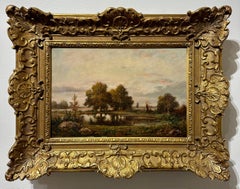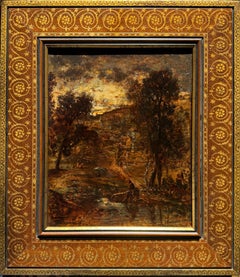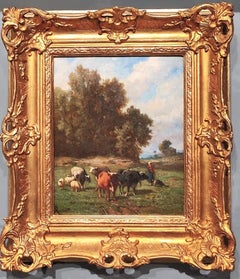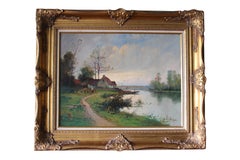Théodore Rousseau Paintings
to
1
1
Overall Width
to
Overall Height
to
2
1
1
2
2
1
1
1
2
780
712
712
687
2
2
Artist: Théodore Rousseau
Mare en foret de Fountainebleau, Barbizon
By Théodore Rousseau
Located in New York, NY
Theodore Rousseau
French, 1812- 1867
Mare en foret de Fountainbleau
Oil on panel
10 1/2 x 16 1/4 inches (26.7 x 41.3 cm.)
Framed: 18 1/2 x 23 1/2 inches (47 x 59.7 cm.)
Signed lower ...
Category
1840s Barbizon School Théodore Rousseau Paintings
Materials
Oil, Panel
Theodore Rousseau COUCHE De Solei Oil Painting
By Théodore Rousseau
Located in Dallas, TX
Théodore Rousseau (French, 1812-1867)
Personnages sur un sentier escarpé au coucher de soleil, 1845-50
Oil on paper laid on canvas
Canvas: 12 x 9.75 inches (30.5 x 24.8 cm)
Frame: 18...
Category
1840s Barbizon School Théodore Rousseau Paintings
Materials
Oil, Canvas, Laid Paper
Related Items
Shepherdess at the edge of the forest
Located in Gent, VOV
"Robbe Louis, “Plein air” Animal Painter"
ROBBE Louis Born in Courtrai on November 17, 1806, died in Brussels on May 2, 1887. Pupil of Eugène Verboeckchoven and Jean-Baptiste De Jonghe...
Category
Mid-19th Century Barbizon School Théodore Rousseau Paintings
Materials
Canvas, Oil
Antique original riverside oil painting Barbazon style Eugene Galien-Laloue
By Eugene Galien-Laloue
Located in AIGNAN, FR
Original large antique riverside oil painting on canvas by French artist Eugene Galien-Laloue (1854-1941). A calming and traditional French oil on canvas by this respected and ren...
Category
Late 19th Century Barbizon School Théodore Rousseau Paintings
Materials
Oil
"a Fontainebleu, " Charles Francis DeKlyn, Barbizon, Oil, French Countryside
Located in Wiscasset, ME
Charles Francis De Klyn was born in Westchester County, New York, in 1865. A landscape, marine, portrait and figure painter, De Klyn studied in New York and Paris from 1886 to 1891, then taught at the Cleveland Art Club and the Cleveland School of Art. In 1893, he was one of the founders of the Cleveland Brush and Palette Club, and he exhibited at the National Academy of Design in 1894 and 1895. He was also a member of the Society of Western Artists.
"A Fontainebleu" by Charles Francis De Klyn is a beautifully rendered Barbizon oil...
Category
Late 19th Century Barbizon School Théodore Rousseau Paintings
Materials
Oil, Panel
$2,500
H 21.5 in W 18.25 in
"Near Bourron, France" Gilbert Munger, Barbizon School, Countryside Landscape
Located in New York, NY
Gilbert Munger
Near Bourron, France, circa 1886
Signed lower left
Oil on panel
13 x 18 inches
Gilbert Munger was born on April 14, 1837 in Madison, Connecticut. He showed interest ...
Category
1880s Barbizon School Théodore Rousseau Paintings
Materials
Oil, Wood Panel
French Barbizon rural landscape: young girls chatting by the village gates
Located in Norwich, GB
Godefroy de Hagemann (1820-1877) was a member of the Hanover dynasty, of German Princes. His full name was Godefroy Auguste Christian Volfgann baron de Hagemann, or Godefroy de Hagem...
Category
Mid-19th Century Barbizon School Théodore Rousseau Paintings
Materials
Canvas, Oil
$3,800
H 24.81 in W 30.32 in D 2.37 in
Washerwomen in Landscape
Located in Hinsdale, IL
This is beautiful little 19th century oil painting on panel. Painted in the barbizon school style. It is a lovely example of pastoral artwork, depicting a sweet little country scen...
Category
1850s Barbizon School Théodore Rousseau Paintings
Materials
Oil
Barbizon School 19th Century Oil Painting Sunlit Forest Path Birch Trees Framed
Located in Buffalo, NY
This luminous 19th century oil on canvas captures a serene woodland path dappled with golden afternoon light. The artist’s masterful brushwork conveys both the weight and texture of ...
Category
1890s Barbizon School Théodore Rousseau Paintings
Materials
Canvas, Oil
$3,775
H 21 in W 19 in D 2 in
Late 19th-Century Calming Landscape
Located in San Francisco, CA
This late 19th-century (or early 20th) painting can have a deeply calming effect on the viewer. Based on the framing label, which points to a supplier located at the time in The Hagu...
Category
Late 19th Century Barbizon School Théodore Rousseau Paintings
Materials
Canvas, Oil
19th Century French Barbizon Signed Oil Painting Cattle & Dog in Rural Lane
Located in Cirencester, Gloucestershire
Jacques Alfred Brielman (1836-1892) French.
A Landscape with Cattle and a Dog in a Rural Lane,
Oil on Canvas, Signed,
Unframed 15" x 23" (38 x 58.5cm)
condition: overall very good,...
Category
Mid-19th Century Barbizon School Théodore Rousseau Paintings
Materials
Canvas, Oil
Barbizon School Landscape, The Poplar Trees, Late 19th Century Oil on Wood Panel
Located in Cotignac, FR
Late 19th Century French Barbizon School oil on wood panel of poplar trees in a landscape by Richard. The painting is signed bottom left. The painting is on a quality chamfered panel.
A very charming, almost impressionist, rendition of a line of iconic French trees in a landscape. Before them an earth drive has been ploughed up by the wheels of passing carts and horses. Richard has created a wonderful perspective that draws us in to the painting and he has created a contrast between the strong greens of the trees and fields against the whites and blues of the sky. The painting is reminiscent of the works of Monet from the 1890s. to whom the poplar trees were a continuing inspiration.
The Barbizon school of painters was part of an art movement towards Realism in art, which arose in the context of the dominant Romantic Movement of the time. The Barbizon school was active roughly from 1830 through 1870. It takes its name from the village of Barbizon, France, on the edge of the Forest of Fontainebleau, where many of the artists gathered. Most of their works were landscape paintings, but several of them also painted landscapes with farmworkers, and genre scenes of village life. Some of the most prominent features of this school are its tonal qualities, colour, loose brushwork, and softness of form.
The leaders of the Barbizon school were: Théodore Rousseau, Charles-François Daubigny, Jules Dupré, Constant Troyon, Charles Jacque, and Narcisse Virgilio Díaz. Jean-François Millet lived in Barbizon from 1849, but his interest in figures with a landscape backdrop sets him rather apart from the others. Jean-Baptiste-Camille Corot was the earliest on the scene, first painting in the forest in 1829, but his work has a poetic and literary quality which sets him somewhat apart. Other artists associated with the school, often pupils of the main group, include: Henri Harpignies, Albert Charpin, François-Louis Français and Émile van Marcke.
In 1824 the Salon de Paris exhibited works of John Constable, an English painter. His rural scenes influenced some of the younger artists of the time, moving them to abandon formalism and to draw inspiration directly from nature. Natural scenes became the subjects of their paintings rather than mere backdrops to dramatic events. During the Revolutions of 1848 artists gathered at Barbizon to follow Constable's ideas, making nature the subject of their paintings. The French landscape became a major theme of the Barbizon painters.
Millet extended the idea from landscape to figures — peasant figures, scenes of peasant life, and work in the fields. In The Gleaners (1857), for example, Millet portrays three peasant women working at the harvest. Gleaners are poor people who are permitted to gather the remains after the owners of the field complete the main harvest. The owners (portrayed as wealthy) and their laborers are seen in the back of the painting. Millet shifted the focus and the subject matter from the rich and prominent to those at the bottom of the social ladders. To emphasize their anonymity and marginalized position, he hid their faces. The women's bowed bodies represent their everyday hard work.
In the spring of 1829, Jean-Baptiste-Camille Corot came to Barbizon to paint in the Forest of Fontainebleau, he had first painted in the forest at Chailly in 1822. He returned to Barbizon in the autumn of 1830 and in the summer of 1831, where he made drawings and oil studies, from which he made a painting intended for the Salon of 1830; "View of the Forest of Fontainebleau'" (now in the National Gallery in Washington) and, for the salon of 1831, another "View of the Forest of Fontainebleau"'. While there he met the members of the Barbizon school: Théodore Rousseau, Paul Huet, Constant Troyon, Jean-François Millet, and the young Charles-François Daubigny.
During the late 1860s, the Barbizon painters attracted the attention of a younger generation of French artists studying in Paris. Several of those artists visited Fontainebleau Forest to paint the landscape, including Claude Monet, Pierre-Auguste Renoir, Alfred Sisley and Frédéric Bazille. In the 1870s those artists, among others, developed the art movement called Impressionism and practiced 'plein air' painting. In contrast, the main members of the school made drawings and sketches on the spot, but painted back in their studios.
The Post-Impressionist painter Vincent Van Gogh studied and copied several of the Barbizon painters as well, including 21 copies of paintings by Millet. He copied Millet more than any other artist. He also did three paintings in Daubigny's Garden.
The Barbizon painters also had a profound impact on landscape painting in the United States. This included the development of the American Barbizon school by William Morris Hunt. Several artists who were also in, or contemporary to, the Hudson River School studied Barbizon paintings for their loose brushwork and emotional impact. A notable example is George Inness, who sought to emulate the works of Rousseau. Paintings from the Barbizon school also influenced landscape painting in California. The artist Percy Gray...
Category
Late 19th Century Barbizon School Théodore Rousseau Paintings
Materials
Oil, Wood Panel
$813
H 8.47 in W 10.83 in
Rooster and Hens in the Barnyard William Baptiste Baird (U.S./France 1847-1917)
Located in SANTA FE, NM
Rooster and Hens in the Barnyard
William Baptiste Baird (U.S./France 1847-1917)
Oil on panel
Signed lower right "W. Baird"
12 1/4 x 9 inches
A stunning example of William Baptiste...
Category
1880s Barbizon School Théodore Rousseau Paintings
Materials
Oil, Wood Panel
River Cottage 1849/ Barbizon landscape heralding Impressionism Jongkind's friend
By Henri Sieurac
Located in Norwich, GB
A wonderful view of a river landscape with a rustic cottage and pollarded trees by Henri Sieurac. It isa rare, early and very fresh landscape by this Parisian artist which may well have been painted in the countryside around Barbizon, near the river Loing.
Henry Sieurac had studied with his father, François Joseph Sieurac , and of Paul Delaroche...
Category
1840s Barbizon School Théodore Rousseau Paintings
Materials
Canvas, Oil
$1,450
H 13.39 in W 16.54 in D 1.19 in
Théodore Rousseau paintings for sale on 1stDibs.
Find a wide variety of authentic Théodore Rousseau paintings available for sale on 1stDibs.



